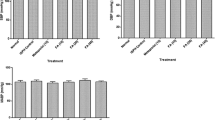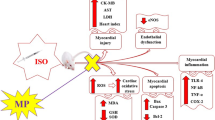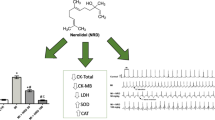Abstract
This study investigated the cardioprotective effect of N-acetylcysteine (NAC) on isoproterenol (ISO)-induced cardiotoxicity in rats. Male Sprague–Dawley rats were divided into control, NAC alone (100 mg/kg BW orally for 14 days), ISO-control (85 mg/kg BW), and ISO with NAC (for 14 days). Serum creatine kinase-MB and Lactate dehydrogenase were measured. From the heart homogenate lipid hydroperoxides (LPO), superoxide dismutase (SOD), total glutathione (GSH), and 8-isoprostane (IP) were measured. Histopathological examination of the heart was also carried out. There was a significant increase (P < 0.05) in LPO and IP levels in ISO-control group and NAC treatment reduced these changes. Antioxidant enzyme, SOD and GSH, level decreased significantly (P < 0.05) in ISO-control group, and treatment with NAC was able to reverse these changes significantly (P < 0.05). Histopathologically, ISO-control group showed morphological changes suggestive of cardiotoxicity with large areas of coagulative necrosis, with diffused interstitial edema. NAC treatment successfully reduced these histopathological changes. In conclusion, the study proves that NAC has a strong cardioprotective effect against isoproterenol-induced cardiac changes. NAC decreases isoproterenol-induced LPO and IP levels in the heart tissue and prevented free radicals–induced damage to the myocardium.

Similar content being viewed by others
References
Lopez, A. D., & Murrau, C. C. (1998). The global burden disease, 1990–2020. Nature Medicine, 4, 1241–1243.
Towbin, J. A. (2001). Molecular genetic basis of sudden cardiac death. Cardiovascular Pathology, 10, 283–295.
Smith, G. D., Shipley, M. J., Marmot, M. G., & Rose, G. (1992). Plasma cholesterol concentration and mortality. The Whitehall study. The Journal of the American Medical Association, 267, 70–76.
Thygesen, K., Alpert, J. S., & White, H. D. (2007). Universal definition of myocardial infarction. Journal of American College of Cardiology, 50, 2173–2195.
Choudhary, R., Mishra, K. P., & Subramanyam, C. (2006). Prevention of isoproterenol-induced cardiac hypertrophy by eugenol, an antioxidant. Indian Journal of Clinical Biochemistry, 21, 107–113.
Libby, P. (2001). Current concepts of pathogenesis of the acute coronary syndromes. Circulation, 104, 365–372.
Lilly, L. S. (2006). Pathophysiology of heart disease: A collaborative project of medical students and faculty (4th ed., pp. 131–184). Baltimore, MD: Lippincott Williams & Wilkins.
Ferrari, R., Alfieri, O., Curello, S., Ceconi, C., Cargnoni, A., & Marzollo, P. (1990). Occurrence of oxidative stress during reperfusion of the human heart. Circulation, 81, 201–211.
Lefer, D. J., & Grabger, D. N. (2000). Oxidative stress and cardiac disease. American Journal of Medicine, 109, 315–323.
Zhou, R., Xu, Q., Zheng, P., Yan, L., Zheng, J., & Dai, G. (2008). Cardioprotective effect of fluvastatin on isoproterenol-induced myocardial infarction in rat. European Journal of Pharmacology, 586, 244–250.
Lawson, J. S., Rokach, J., & Fitzgerald, G. A. (1999). Isoprostanes: Formation, analysis and sue as indices of lipid peroxidation in vivo. The Journal of Biological Chemistry, 274, 24441–24444.
Cracowski, J. L., Durand, T., & Bessard, G. (2002). Isoprostanes as a biomarker of lipid peroxidation in humans: Physiology, pharmacology, and clinical implications. Trends in Pharmacological Sciences, 23, 360–366.
Morrow, J. D., & Roberts, L. J. (1996). The isoprostanes. Current knowledge and directions for future research. Biochemical Pharmacology, 51, 1–9.
Rajadurai, M., Mainzen, S., & Prince, P. (2006). Preventive effect of naringin on lipids, lipoproteins and lipid metabolic enzymes in isoproterenol-induced myocardial infarction in Wistar rats. Journal of Biochemical and Molecular Toxicology, 20, 191–197.
Rathore, N., John, S., Kale, M., & Bhatnagar, D. (1998). Lipid peroxidation and antioxidant enzymes in isoproterenol-induced oxidative stress in rat tissues. Pharmacological Research, 38, 297–303.
Arstall, M. A., Yang, J., Stafford, I., Betts, H., & Horowitz, J. D. (1995). N-acetylcysteine in combination with nitroglycerin and streptokinase for the treatment of evolving myocardial infarction. Circulation, 92, 2855–2862.
Kerksick, C., & Willoughby, D. (2005). The antioxidant role of glutathione and N-acetylcysteine supplements and exercise-induced oxidative stress. The Journal of the International Society of Sports Nutrition, 2, 38–44.
Keles, M. S., Demirci, N., Yildirim, A., Atamanalp, S. S., & Altinkaynak, K. (2008). Protective effects of N-acetylcysteine and Ginkgo biloba extract on ischaemia-reperfusion-induced hepatic DNA damage in rats. Clinical and Experimental Medicine, 8, 193–198.
Banerjee, S. K., Sood, S., Dinda, A. K., Das, T. K., & Maulik, S. K. (2003). Chronic oral administration of raw garlic protects against isoproterenol-induced myocardial necrosis in rat. Comparative Biochemistry Physiology Toxicology Pharmacology, 136, 377–386.
Krenek, P., Kmecova, J., Kucerova, D., Bajuszova, Z., Musil, P., & Gazova, A. (2009). Isoproterenol-induced heart failure in the rat is associated with nitric oxide-dependent functional alterations of cardiac function. European Journal of Heart Failure, 11, 140–146.
Fozzard, H. A. (1975). Validity of myocardial infarction model. Circulation, 52, 131–146.
Panda, V. S., & Naik, S. R. (2008). Cardioprotective activity of Ginkgo biloba phytosomes in isoproterenol-induced myocardial necrosis in rats: A biochemical and histoarchitectural evaluation. Experimental and Toxicologic Pathology, 60, 397–404.
Grimm, D., Elsner, D., Schunkert, H., Pfeifer, M., Griese, D., Bruckschlegel, G., et al. (1998). Development of heart failure following isoproterenol administration in the rat: Role of the renin-angiotensin system. Cardiovascular Research, 37, 91–100.
Senthil, S., Sridevi, M., & Pugalendi, K. V. (2007). Cardioprotective effect of oleanolic acid on isoproterenol-induced myocardial ischemia in rats. Toxicologic Pathology, 35, 418–423.
Liu, B., Li, W., Li, Y., Wang, Z., Li, H., Liu, P., et al. (2009). Protective effects of N-acetylcysteine in isoproterenol-induced myocardium injury in rats. Molecular Biology Reports, 36, 761–765.
Nagoor Meeran, M. F., & Mainzen Prince, P. S. (2011). Protective effects of N-acetylcysteine on lipid peroxide metabolism on isoproterenol-induced myocardial infarcted rats. Journal of Biochemical and Molecular Toxicology, 25, 151–157.
Pinelli, A., Trivulzio, S., Tomasoni, L., Brenna, S., Bonacina, E., & Accinni, R. (2004). Isoproterenol-induced myocardial infarction in rabbits Protection by propanolol or labetolol: A proposed non-invasive procedure. The European Journal of Pharmaceutical Sciences, 23, 277–285.
Wang, S. B., Tian, S., Yang, F., Yang, H. G., Yang, X. Y., & Du, G. H. (2009). Cardioprotective effect of salvianolic acid—A on isoproterenol-induced myocardial infarction in rats. European Journal of Pharmacology, 615, 125–132.
Peer, P. A., Trivedi, P. C., Nigade, P. B., Ghaisas, M. M., & Deshpande, A. D. (2008). Cardioprotective effect of Azadirachta indica A. Juss. On isoprenaline induced myocardial infarction in rats. International Journal of Cardiology, 126, 123–126.
Upaganlawar, A., Gandhi, C., & Balaraman, R. (2009). Effect of green tea and vitamin E combination in Isoproterenol-induced myocardial infarction in rats. Plant Foods and Human Nutrition, 64, 75–80.
Wittstein, I. S., Thiermann, D. R., Lima, J. A. C., Baughman, K. L., Schulman, S. P., & Gerstenblith, G. (2005). Neurohumoral features of myocardial stunning due to sudden emotional stress. New England Journal of Medicine, 352, 539–548.
Bolli, R., & Marbán, E. (1999). Molecular and cellular mechanisms of myocardial stunning. Physiological Reviews, 79, 609–634.
Dikshit, M., Van Oosten, M. H., de Graff, S., & Srimal, R. C. (1992). Free radical scavenger mechanisms in experimentally induced ischemia in the rabbit heart and protective effect of verapamil. Archives of International Pharmacodynamics Therapy, 318, 55–65.
Remiao, F., Carmo, H., Carcalho, F. D., & Bastos, M. L. (2000). Inhibition of glutathione reductase by isoproterenol-induced oxidation products. Journal of Enzyme Inhibition and Medicinal Chemistry, 15, 47–61.
Mathew, S., Menon, P. V. G., & Kurup, P. A. (1978). Changes in myocardial and aortic lipids, lipolytic activity and fecal excretion of sterols and bile acids in isoproterenol-induced myocardial infarction in rats. Indian Journal Biochemistry, 18, 131–133.
Bloom, S., & Davis, D. L. (1972). Calcium as mediator of isoproterenol-induced myocardial necrosis. American Journal of Pathology, 69, 459–470.
Boucher, M., Pesant, S., Lei, Y. H., Nanton, N., Most, P., & Eckhart, A. D. (2008). Simultaneous administration of insulin-like growth factor-1 and darbepoetin alfa protects the rat myocardium against myocardial infarction and enhances angiogenesis. Clinical and Translational Science, 1, 13–20.
Montuschi, P., Ciabattoni, G., Paredi, P., du Bois, R. M., Pantelidis, P., Kharitonov, S. A., et al. (1998). 8-Isoprostane as a biomarker of oxidative stress in interstitial lung disease. American Journal Respiratory Critical Care Medicine, 158, 1524–1527.
Maier, C. M., & Chan, P. H. (2002). Book review: Role of superoxide dismutases in oxidative damage and neurodegenerative disorders, vol. 8, issue no. 4. Beverley Hills: Sage.
Bolli, R. (1990). Mechanism of myocardial stunning. Circulation, 82, 723–738.
Dickey, D. T., Muldoon, L. L., Doolittle, N. D., Peterson, D. R., Kraemer, D. F., & Neuwelt, E. A. (2008). Effect of N-acetylcysteine route of administration on chemoprotection against cisplatin-induced toxicity in rat models. Cancer Chemotherapy and Pharmacology, 62, 235–241.
Suke, S. G., Ahmed, R. S., Pathak, R., Tripathi, A. K., & Banerjee, B. D. (2008). Attenuation of phosphamidon-induced oxidative stress and immune dysfunction in rats treated with N-acetylcysteine. Brazilian Journal of Medicine Biology Research, 41, 765–768.
Nagoor Meeran, M. F., & Mainzen Prince, P. S. (2011). Protective effects of N-acetylcysteine on lipid peroxide metabolism on isoproterenol-induced myocardial infarcted rats. Journal of Biochemical and Molecular Toxicology, 25, 151–157.
Basha, R. H., Priscilla, D. H. (2011). An in vivo and in vitro study on the protective effects of N-acetylcysteine on mitochondrial dysfunction in isoproterenol treated myocardial infarcted rats. Experimental and Toxicologic Pathology, 3 Jun 2011 [Epub ahead of print].
Decaro, L., Ghizzi, A., & Costa, R. (1989). Pharmacokinetics and bioavailability of oral acetylcysteine in healthy volunteers. Arzneimittel Forchung, 39, 382–385.
Abe, M., Takiguchi, Y., Ichimaru, S., Tsuchiya, K., & Wada, K. (2008). Comparison of the protective effect of N-acetylcysteine by different treatments on rat myocardial ischemia-reperfusion injury. Journal of Pharmacological Sciences, 106, 571–577.
Finkel, M. S., Shen, L., Oddis, C. V., Romeo, R. C., & Salama, G. (1993). Positive inotropic effect of acetylcysteine in cardiomyopathic Syrian hamsters. Journal of Cardiovascular Pharmacology, 21, 29–34.
Zaidi, N. F., Lagenaur, C. F., Abramson, J. J., Pessah, I., & Salama, G. (1989). Reactive disulfides trigger Ca2+ release from sarcoplasmic reticulum via an oxidation reaction. Journal of Biological Chemistry, 264, 21725–21736.
Acknowledgments
The research is funded by a research grant from International Medical University (IMU), Kuala Lumpur, Malaysia.
Conflict of interest
The authors declare that there are no conflicts of interest.
Author information
Authors and Affiliations
Corresponding author
Rights and permissions
About this article
Cite this article
Haleagrahara, N., Julian, V. & Chakravarthi, S. N-acetylcysteine Offers Cardioprotection by Decreasing Cardiac Lipid Hydroperoxides and 8-Isoprostane Level in Isoproterenol-Induced Cardiotoxicity in Rats. Cardiovasc Toxicol 11, 373–381 (2011). https://doi.org/10.1007/s12012-011-9132-0
Published:
Issue Date:
DOI: https://doi.org/10.1007/s12012-011-9132-0




